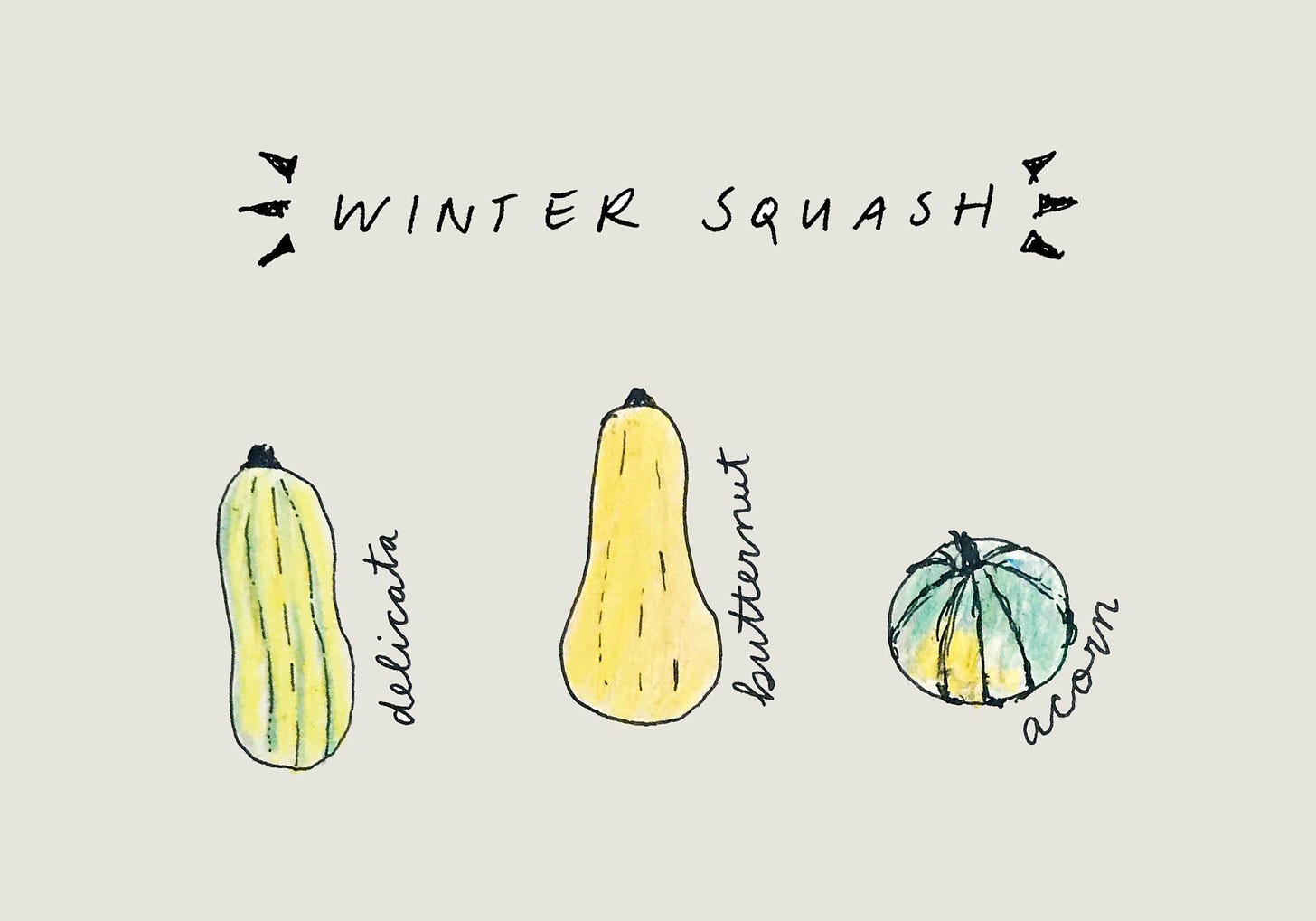Winter Squash, Butternut Bundt Cake, Shop Re-Stock Updates
#41: Winter Happenings @ Featherstone Garden
Welcome to Featherstone’s Winter Happenings Newsletter. Each week we share a rotating variety of garden updates: from heirloom seasonal produce features, to farm fresh subscriptions, veg-ed(ucation) content, plant-centered recipes, community partners, and more. As a subscriber, you will be the first to know all about our Garden Happenings. If you’re not a newsletter subscriber but would like to be, click below to signup.
Happy New Year!
Welcome back to the Winter edition of our Garden Happenings newsletter. We hope everyone enjoyed the holidays and NYE festivities to the fullest
A quick reminder:
For anyone interested in procuring our homemade goods and pantry staples, or if you received a Featherstone gift cards for the holidays, you can expect our online shop and to be re-stocked with new items on January 20th. As a reminder, gift cards can be applied to any of our products or weekly subscriptions.
——
Weekly Microgreens are back!
If you’re setting healthy eating goals for the new year, we got you! The start of our 6-week Mircrogreens subscriptions is just around the corner @ $10/week.
[Edited 1/11] Subscription Cycle: Starts January 25, 2022 - March 1, 2022
PICKUP: Every Tuesday 12pm - 3pm at the Featherstone Nursery
➞ 1021 Manistique St. Detroit, MI 48215
*Please note that we are offering pickup only throughout this cycle. We will resume delivery in the summer months.
Tis the Season for Squash
By Renee
Winter squash, that is. The proper name for the all encompassing squash/melon/gourd umbrella is cucurbitaceae—consisting over 975 species. While reading up on these hearty vegetables, I was interested to learn that buffalo gourds were once used by Native Americans in both North & Central America as a soap, shampoo, insecticide, medicine, ceremonial instrument, disinfectant, laxative, and food. Though nowadays, they’re less known and less likely to be used for consumption.
As for the tasty and more well known winter squash varieties (e.g. butternut, acorn, kabocha), these contain an important source of carotenoids and many antioxidants such as: Vitamins A & C, potassium, manganese, folate, some omega-3 fatty acids, and various amounts of B vitamins. Using the whole plant to prevent food waste is always our goal, and I found a few suggestions for doing just that in Debora Madison’s book, Vegetable Literacy. Here are her tips:
Using the Whole Plant:
You can use the seeds and fibers to make a quick soup stock for a winter squash soup or a risotto. If you’ve roasted the squash first, you can still use them, along with the cooked skins.
To turn the trimmings into a sauce, simmer the seeds and pump in 3 cups water for 30 minutes, then strain, reduce the liquid to 1/2 cup, and stir in 1 to 2 tablespoons tahini. Use this to spoon over roasted squash, rice, or even another vegetable.
The seeds can be salted and roasted for snacking.
To roast: Rinse the scooped out seeds, then put them in salted water (use 1/2 teaspoon sea salt per cup of water) and soak for several hours. Soaking will further loosen the fibers, so that when you rinse them a second time, the seeds should come clean. Spread the seeds on a kitchen towel to dry.
Heat the oven to 300°F. Toss seeds with a little sunflower seed oil, sea salt, or whatever inspires you—tamari, soy sauce, butter. Spread them on a sheet pan and roast until golden, about 15 minutes. They’ll become crispier as they cool. Store in an airtight container at room temp.
A Few Squash Pairing Suggestions
You can think of this list as a starting off point and have fun with mixing and matching different flavor profiles with your favorite squash recipes.
Make the most of your squash by drizzling with a high quality olive oil, butter, cream, ghee, full fat coconut milk, or a simple miso sauce.
Herb suggestions: Sage, mint, rosemary, or basil.
Spice suggestions: Cinnamon, nutmeg, fresh grated ginger, cardamom.
Garnish suggestions: Walnuts, shaved almonds, hazelnuts, pine nuts, sliced fruit, medjool dates, feta, gorgonzola.
Three Recipes: Squash-centric Staff Picks
Annie’s pick: Tuscan White Bean Kale Soup with Winter Squash by Florentina.
Jessi’s pick: Quinoa Stuffed Acorn Squash by Melissa Huggins.
Renee’s pick: Brown Buttered Squash, Dates & Walnuts by Alison Roman.
7-Spice Butternut Squash Bundt Cake (gluten free!)
Yields: 1 large or 2 mini bundt cakes
Ingredients:
1/2 cup unsalted butter, browned
2 tbsp olive oil
1 cup super fine brown rice flour
2/3 cup oat flour
1/4 cup tapioca starch
1/2 tsp baking soda
3/4 tsp salt
1/2 cup granulated sugar
1/2 cup dark brown sugar, plus 2 tbsp (for the squash)
3 eggs, beaten
1 tsp vanilla extract
3/4 cup shredded parsnip or carrot
3/4 cup pureed butternut squash, (about 1/2 of the squash)
1 orange, finely grated and squeezed (about 2 tsp zest, and 2 tbsp juice)
7 spices*
1 teaspoon grated ginger root
2 teaspoon cinnamon, divided
1/2 teaspoon coriander
1/2 teaspoon cardamom
1/4 teaspoon ground nutmeg
1/4 tsp all spice
1/4 tsp pink peppercorn
*A note on spices: If you do not have all 7 spices, you can use extra of whatever spices you have on hand. You will want to add approx. 4-5 teaspoons of spices in a similar flavor profile to those listed above.
Directions:
For the squash, pre-heat oven to 400ºF
Cut the butternut squash in half, lengthwise. Scoop out seeds, and set aside one half (we’ll only be using half for this recipe). Drizzle with olive oil, sprinkle with pinch of salt, 2 tbsp brown sugar and 1 tsp cinnamon (save the other 1 tsp of cinnamon for the cake batter). Bake one half of the squash, cut-side up for 40-50 minutes.
While the squash is baking, cut the unsalted butter into small(ish) chunks. Add to a heavy bottomed pan (preferably light in color; this makes it easier to tell when the butter darkens/turns into ‘brown butter’). Turn stove to medium-high heat and brown the butter. I previously posted helpful tips on a past post here, and you can also check out this youtube video for a thorough step-by-step guide. Pour into a bowl and set aside to cool.
Once your timer goes off for the squash, check that the top is lightly browned; a fork should be able to pierce the squash easily. Allow to cool completely. Once cooled, peel off the skin, add squash to a blender, and blend until smooth. Set aside.
Grate parsnip or carrots into coarse shreds with a box grater. Set aside.
In a large bowl, mix together brown rice flour, oat flour, tapioca starch, baking soda, salt, both sugars, and all dry spices (hold off on adding the freshly grated ginger until the next step)
In the same bowl of dry ingredients, add in the the brown butter, pureed squash, shredded parsnip or carrot, beaten eggs, grated orange zest, orange juice, grated ginger, and vanilla extract. Mix until smooth.
Pre-heat oven to 350ºF.
Prepare your bundt cake pan (one large pan, or two mini pans) by evenly coating melted butter or olive oil with a pastry brush, or you can use cooking spray.
Pour batter into bundt pan and bake for 40-45 minutes. Top should be lightly golden brown, and toothpick should come out clean. Allow the cake to cool in the pan for 10-15 minutes, then flip and allow to cool on a cooling rack. Once cooled completely, sprinkle with powdered sugar and serve.
Enjoy!
For additional recipe notes and bundt cake pan suggestions, head to the link below to see Renee’s original blog post for this recipe.
Thanks for reading!
For more about our garden, follow us on instagram (@featherstone.garden), and check out our website. Feel free to email us or comment below with any questions or suggestions. We’d love for you to share our newsletter with a friend by clicking the button below.
Have a great week,
Annie, Aaron, Renee, Jessi + Chili & Bean (our farm cats)











Great post! I'll be using the recipes. I love growing butternut & acorn squash but I get stuck in a rut of just roasting & scooping them.